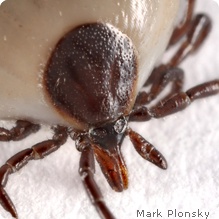We have much more to do and your continued support is needed now more than ever.
Fight the Bite! 6 Common Questions about Lyme Disease
Guest post by Carol Torgan, Ph.D.
 From a human’s perspective, the tick falls into a very small category of “not-so-great” aspects of the great outdoors. (Others in the category? Poison ivy, sunburn, and mosquitoes.) A tick feeds on blood and will gladly bite into any exposed skin that comes near it. In rare cases, a tick bite may cause Lyme disease, which can cause a variety of health issues. But with a little common sense and some simple precautions, you can avoid these tiny but troublesome creatures.
From a human’s perspective, the tick falls into a very small category of “not-so-great” aspects of the great outdoors. (Others in the category? Poison ivy, sunburn, and mosquitoes.) A tick feeds on blood and will gladly bite into any exposed skin that comes near it. In rare cases, a tick bite may cause Lyme disease, which can cause a variety of health issues. But with a little common sense and some simple precautions, you can avoid these tiny but troublesome creatures.
Here are 6 common questions and answers about Lyme disease:
What is Lyme disease?
Lyme disease is a bacterial infection that you can get from being bitten by an infected tick. Lyme disease is carried by the black-legged tick, also known as the dear tick. These ticks are very small, about the size of a sesame seed, and are usually found in wooded areas or areas with tall grasses, especially alongside trails. In the U.S., most infected ticks live in the Northeast, the upper Midwest, and the West Coast. The disease is named after Lyme, Connecticut, which is the town where it was discovered.
How do I prevent Lyme disease?
The best way to prevent Lyme disease is to prevent ticks from feasting on you. During tick season or in areas where ticks are likely to be found, follow these simple precautions:
- Wear a hat, long pants, long sleeves, and shoes or boots rather than sandals.
- Tuck your pants into your socks or boots and tuck in your shirt.
- Wear white or light colored clothing so it’s easier to spot ticks.
- Stay on trails.
- Apply an insect repellent containing 10-30 percent DEET to your skin and clothes according to directions on the label. Note: do not apply DEET to the faces and hands of children, or on infants younger than 2 months.
- Shower within a few hours of coming indoors as this can remove unattached ticks.
How do I look for ticks on my body?
Ticks are common, so it’s a good idea to check for ticks every day when working or playing outside, especially during the warmer months. Check your skin carefully for ticks and have someone else check you, too. Check your kids and pets, as well.
What looks like a speck of dirt or new freckle may be a sneaky little tick! Look especially closely:
- in the hair
- in and around the ears
- under the arms
- between the legs
- around the waist
- inside the belly button
- behind the knees
What should I do if I find a tick?
Remove the tick by grabbing it with a pair of fine-tipped tweezers as close to your skin as possible and pulling it straight out. Don’t squeeze or crush it. The mouth-parts may stay attached, but these don’t transmit Lyme disease. Wash the bite area and your hands with rubbing alcohol, an iodine scrub, or soap and water. Keep an eye on the area and your skin for a few months. If you notice a rash, contact your doctor.
Don’t try folklore remedies such as “painting” the tick with nail polish or petroleum jelly, or using a hot match to make the tick detach from the skin. The goal is to remove the tick as quickly as possible rather than waiting for it to detach.
How can I tell if I have Lyme disease? How is it treated?
A classic sign of Lyme disease is a rash in the shape of a bull’s eye. This may show up 3 to 30 days after being bitten at the site of the bite. A rash, however, may not always appear. Other early symptoms of Lyme disease can include:
- fever
- headache
- chills
- muscle pain
- stiff neck
- fatigue
- joint and muscle aches
These symptoms are similar to the flu, as well as to lots of other ailments, so it can be difficult to know if you have Lyme disease, especially if you never noticed the tick bite.
If you think you might have been bitten by a tick and may have Lyme disease, talk to your doctor immediately. Since Lyme disease is a bacterial infection, it’s commonly treated with antibiotics. The earlier the treatment is started, the more effective it will be. The majority of people with this disease recover completely with appropriate treatment.
I’m hearing a lot about Lyme disease. What’s being done to prevent and treat it?
The number of cases of Lyme disease is increasing, and if not treated, in some cases it can lead to health problems such as joint swelling or nervous system disorders. Research is currently underway to find out more about the bacterium that causes Lyme disease, to develop better methods to detect and treat Lyme disease, and to develop a vaccine against it.
Carol Torgan, Ph.D. is an award-winning health scientist, e-health strategist, educator and consultant. She is passionate about improving health by encouraging everyone to go outside and experience their five sense in four dimensions. Her Web site, www.caroltorgan.com, addresses the interplay of science, technology, and movement and includes a list of 100+ top play resources.




















